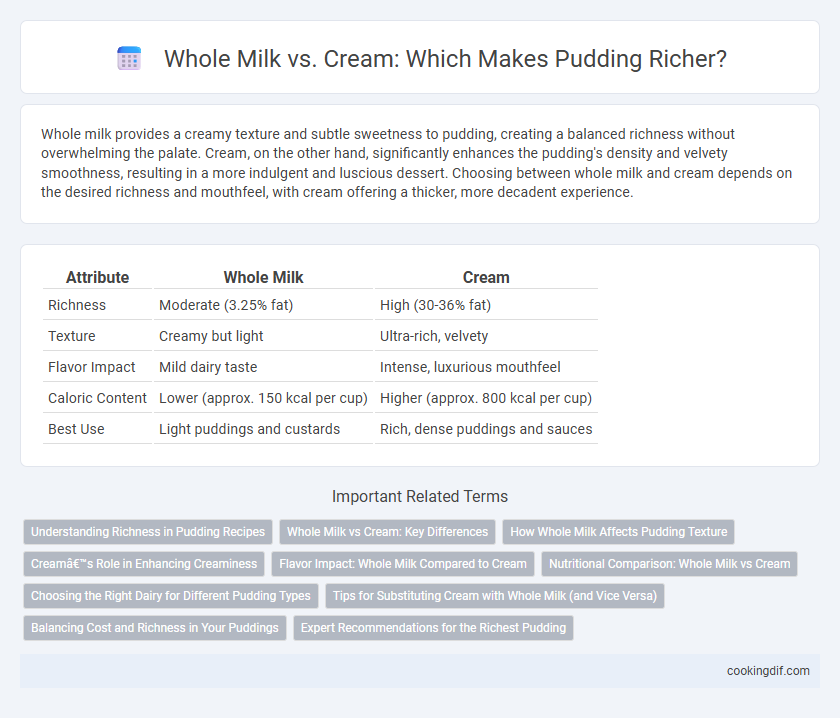Whole milk provides a creamy texture and subtle sweetness to pudding, creating a balanced richness without overwhelming the palate. Cream, on the other hand, significantly enhances the pudding's density and velvety smoothness, resulting in a more indulgent and luscious dessert. Choosing between whole milk and cream depends on the desired richness and mouthfeel, with cream offering a thicker, more decadent experience.
Table of Comparison
| Attribute | Whole Milk | Cream |
|---|---|---|
| Richness | Moderate (3.25% fat) | High (30-36% fat) |
| Texture | Creamy but light | Ultra-rich, velvety |
| Flavor Impact | Mild dairy taste | Intense, luxurious mouthfeel |
| Caloric Content | Lower (approx. 150 kcal per cup) | Higher (approx. 800 kcal per cup) |
| Best Use | Light puddings and custards | Rich, dense puddings and sauces |
Understanding Richness in Pudding Recipes
Whole milk provides a lighter, creamier base for pudding, balancing sweetness and texture without overwhelming richness. Cream, with its higher fat content, offers a luxurious, velvety mouthfeel that intensifies the pudding's depth and flavor complexity. Selecting whole milk or cream directly influences the pudding's consistency and richness, shaping the final sensory experience.
Whole Milk vs Cream: Key Differences
Whole milk provides a lighter, more balanced texture in pudding due to its 3.25% fat content, enhancing creaminess without overpowering other flavors. Cream, with fat content ranging from 30% to 40%, delivers a richer, thicker consistency ideal for indulgent, velvety puddings. Choosing between whole milk and cream depends on desired richness, with cream offering maximum creaminess and whole milk preserving a more subtle, smooth mouthfeel.
How Whole Milk Affects Pudding Texture
Whole milk contributes to a lighter, silkier pudding texture due to its balanced fat content, allowing for a smooth and creamy consistency without being overly dense. The natural proteins and sugars in whole milk enhance the tenderness and subtle sweetness in the pudding, creating a more delicate mouthfeel. Compared to cream, whole milk results in a pudding that is rich but not heavy, maintaining a perfect balance between creaminess and softness.
Cream’s Role in Enhancing Creaminess
Cream plays a vital role in enhancing pudding's creaminess due to its higher fat content compared to whole milk, which contributes to a richer, smoother texture. The presence of butterfat in cream emulsifies with other ingredients, resulting in a luscious mouthfeel and more indulgent flavor profile. Using cream instead of whole milk intensifies the pudding's decadent consistency, making it a preferred choice for achieving luxurious richness.
Flavor Impact: Whole Milk Compared to Cream
Whole milk provides a balanced creaminess with a subtle sweetness that enhances pudding's natural flavors without overpowering them. Cream adds a richer, more indulgent texture and a pronounced dairy flavor, intensifying the overall taste experience. Choosing whole milk over cream results in a lighter pudding with a delicate flavor profile, ideal for those seeking richness without heaviness.
Nutritional Comparison: Whole Milk vs Cream
Whole milk contains approximately 3.25% fat and provides essential nutrients like calcium, vitamin D, and protein, making it a balanced choice for pudding richness with moderate calories. Cream, with a fat content ranging from 30% to 40%, significantly increases the richness and creaminess of pudding but also adds higher saturated fat and calorie content per serving. Choosing whole milk enhances nutritional value while cream intensifies texture, requiring consideration of dietary goals based on fat and calorie intake.
Choosing the Right Dairy for Different Pudding Types
Whole milk provides a lighter, smoother texture ideal for custard-based puddings like creme brulee, while cream offers a richer, thicker consistency perfect for indulgent desserts such as chocolate or butterscotch pudding. Selecting the right dairy depends on the desired richness and mouthfeel; whole milk maintains a balance of creaminess without overpowering flavors, whereas cream enhances decadence and depth. Adjusting the milk-to-cream ratio can customize richness, allowing flexibility for various pudding recipes and dietary preferences.
Tips for Substituting Cream with Whole Milk (and Vice Versa)
Whole milk can replace cream in pudding recipes by reducing the quantity slightly and adding a small amount of butter to maintain richness and texture. Using cream instead of whole milk enhances the pudding's creaminess and thickness but may require adjusting sugar levels to balance sweetness. For optimal results, heat the milk slowly and whisk continuously to prevent curdling and achieve a smooth, velvety consistency.
Balancing Cost and Richness in Your Puddings
Whole milk offers a lighter texture and lower cost, making it ideal for everyday puddings while cream provides a richer, silkier mouthfeel with higher fat content. Balancing cost and richness involves mixing whole milk and cream to achieve a creamy consistency without excessive expense. Adjusting the ratio allows control over the pudding's richness, catering to budget constraints and desired indulgence.
Expert Recommendations for the Richest Pudding
Experts recommend using heavy cream over whole milk to achieve the richest pudding texture and flavor due to its higher fat content, typically around 36-40%. Whole milk contains approximately 3.5% fat, which results in a lighter, less creamy pudding consistency. Incorporating heavy cream enhances the smoothness and richness, creating a luxurious mouthfeel favored by professional chefs and dessert enthusiasts.
Whole milk vs cream for richness Infographic

 cookingdif.com
cookingdif.com